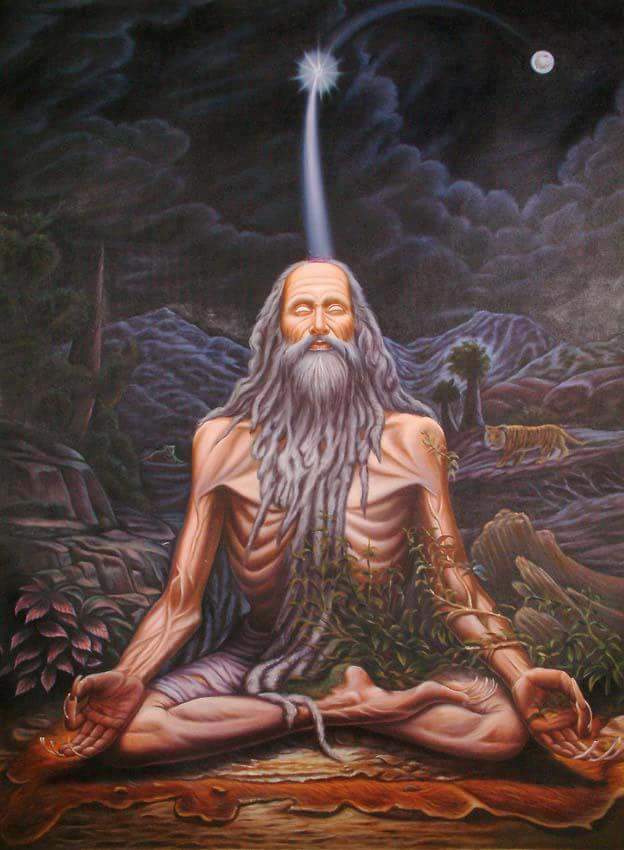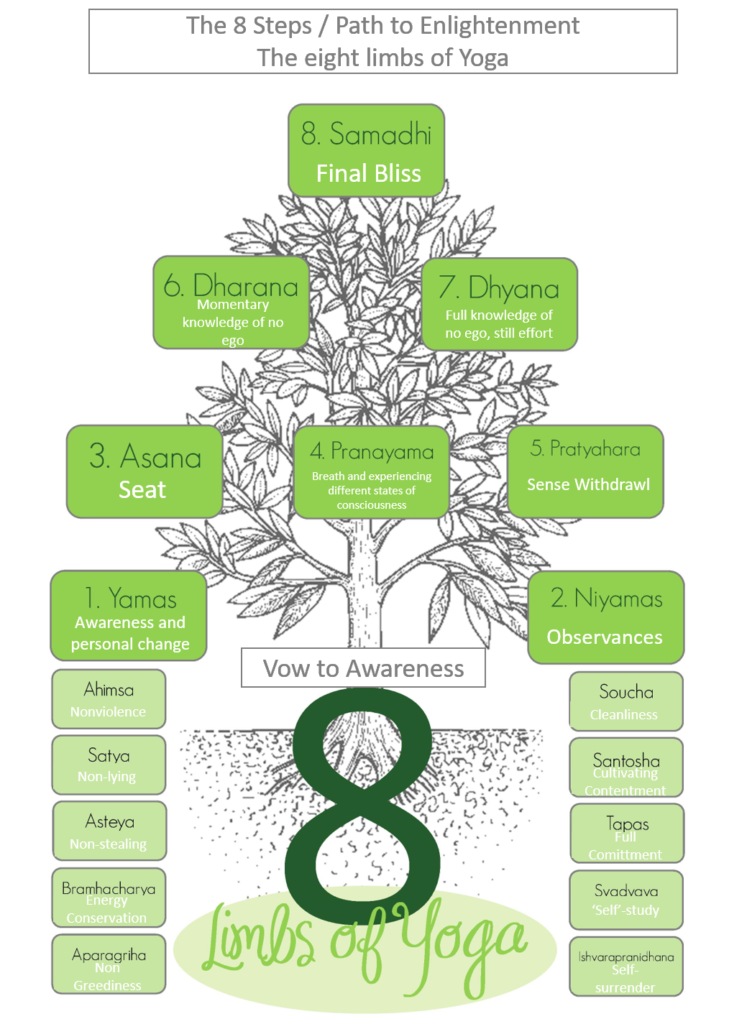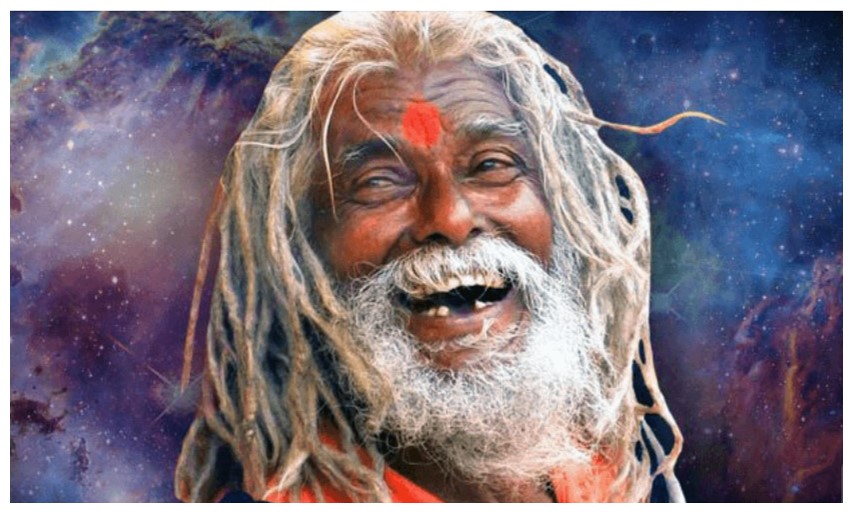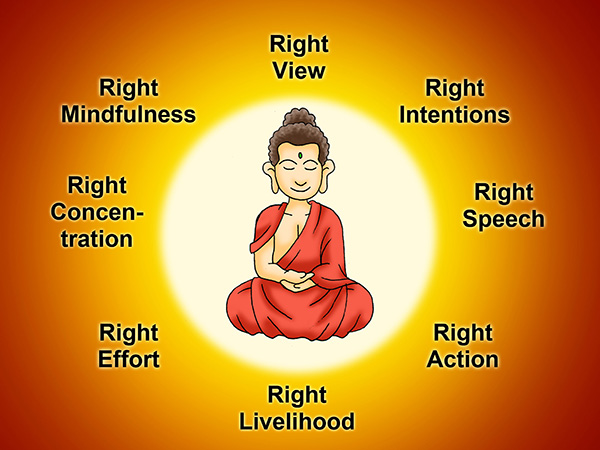PATANJALI - The 8 fold path to enlightenment / 8 limbs of Yoga
What is enlightenment?

8 limbs of Yoga or the eight fold path to enlightenment and What is enlightenment?
I usually call the ‘8 limbs of yoga’ the ‘8 fold path’ or the ‘8 steps to enlighenment’, because for me it’s a journey. This is not to be confused with the Buddhist eight fold path (see the last image on this page).

Assignment
1. Write down any impressions, sensations, reactions you have after listening to this lecture, and how you feel this lecture might (or might not) affect/change your life. Be honest, if you feel it was a bunch of belony… say so too :o)
Click below to download the document by Hareesh on the extra steps in the Yoga Sutras by Patanjali, that are usually never covered in any teachings on Patanjali. This document has been reproduced with permission by the great Hareesh himself.

(Buddhist) 8 fold path
These are from the Buddhist Tradition NOT the vedic tradition

The Buddhist eight fold path reminds us of the Yamas and Niyamas
Comment by Xian: ‘Buddha lived around 500yrs before Jesus and Patanjali (If our dates are right…) so… maybe Patanjali’s download came from Buddhism? Jesus supposedly (in the 10 years where he disappeared) deeply studied vedic and buddhist traditions. Afterwards he came back with Siddhis… (Yogic and Buddhist magical powers of healing, multiplying bread, turning water into wine and much more)…
Now the question is… where did the Buddhist get it from? At a time 2000 years ago, when supposedly we ourselves hadn’t even started the middle ages yet for a very very long time, these cultures mused about enlightenment and the exact steps to get there… makes you think, does it not?….’
The Eightfold Path, Pali Atthangika-magga, Sanskrit Astangika-marga, in Buddhism, an early formulation of the path to enlightenment. The idea of the Eightfold Path appears in what is regarded as the first sermon of the founder of Buddhism, Siddhartha Gautama, known as the Buddha, which he delivered after his enlightenment. There he sets forth a middle way, the Eightfold Path, between the extremes of asceticism and sensual indulgence. Like the Sanskrit term Chatvari-arya-satyani, which is usually translated as Four Noble Truths, the term Astangika-marga also implies nobility and is often rendered as the “Eightfold Noble Path.” Similarly, just as what is noble about the Four Noble Truths is not the truths themselves but those who understand them, what is noble about the Eightfold Noble Path is not the path itself but those who follow it. Accordingly, Astangika-marga might be more accurately translated as the “Eightfold Path of the [spiritually] noble.” Later in the sermon, the Buddha sets forth the Four Noble Truths and identifies the fourth truth, the truth of the path, with the Eightfold Path. Each element of the path also is discussed at length in other texts.
In brief, the eight elements of the path are: (1) correct view, an accurate understanding of the nature of things, specifically the Four Noble Truths, (2) correct intention, avoiding thoughts of attachment, hatred, and harmful intent, (3) correct speech, refraining from verbal misdeeds such as lying, divisive speech, harsh speech, and senseless speech, (4) correct action, refraining from physical misdeeds such as killing, stealing, and sexual misconduct, (5) correct livelihood, avoiding trades that directly or indirectly harm others, such as selling slaves, weapons, animals for slaughter, intoxicants, or poisons, (6) correct effort, abandoning negative states of mind that have already arisen, preventing negative states that have yet to arise, and sustaining positive states that have already arisen, (7) correct mindfulness, awareness of body, feelings, thought, and phenomena (the constituents of the existing world), and (8) correct concentration, single-mindedness.
The Eightfold Path receives less discussion in Buddhist literature than do the Four Noble Truths. In later formulations, the eight elements are portrayed not so much as prescriptions for behaviour but as qualities that are present in the mind of a person who has understood nirvana, the state of the cessation of suffering and the goal of Buddhism.
According to a more widely used conception, the path to enlightenment consists of a threefold training in ethics, in concentration, and in wisdom. Ethics refers to the avoidance of nonvirtuous deeds, concentration refers to the control of the mind, and wisdom refers to the development of insight into the nature of reality. The components of the Eightfold Path are divided among the three forms of training as follows: correct action, correct speech, and correct livelihood are part of the training in ethics; correct effort, correct mindfulness, and correct concentration are included in the training in concentration; and correct view and correct intention are associated with the training in wisdom.
-Donald S. Lopez
The four Noble Truths (Buddhism)
Although the term Four Noble Truths is well known in English, it is a misleading translation of the Pali term Chattari-ariya-saccani (Sanskrit: Chatvari-arya-satyani), because noble (Pali: ariya; Sanskrit: arya) refers not to the truths themselves but to those who understand them. A more accurate rendering, therefore, might be “four truths for the [spiritually] noble”; they are four facts that are known to be true by those with insight into the nature of reality but that are not known to be true by ordinary beings. The Buddha stated in his first sermon that when he gained absolute and intuitive knowledge of the four truths, he achieved complete enlightenment and freedom from future rebirth.
The Four Noble Truths are accepted by all schools of Buddhism and have been the subject of extensive commentary. They may be summarized as follows. The first truth, suffering (Pali: dukkha; Sanskrit: duhkha), is characteristic of existence in the realm of rebirth, called samsara (literally “wandering”). In his final sermon, the Buddha identified as forms of suffering birth, aging, sickness, death, encountering the unpleasant, separation from the pleasant, not gaining what one desires, and the five “aggregates” (skandhas) that constitute the mind and body (matter, sensations, perceptions, mental formations, and awareness).
The second truth is the origin (Pali and Sanskrit: samudaya) or cause of suffering, which the Buddha associated with craving or attachment in his first sermon. In other Buddhist texts the causes of suffering are understood as stemming from negative actions (e.g., killing, stealing, and lying) and the negative mental states that motivate negative actions (e.g., desire, hatred, and ignorance). In those texts, the mental state of ignorance refers to an active misconception of the nature of things: seeing pleasure where there is pain, beauty where there is ugliness, permanence where there is impermanence, and self where there is no self.
The third truth is the cessation of suffering (Pali and Sanskrit: nirodha), commonly called nibbana (Sanskrit: nirvana).
The fourth and final truth is the path (Pali: magga; Sanskrit: marga) to the cessation of suffering, which was described by the Buddha in his first sermon.
The four truths therefore identify the unsatisfactory nature of existence, identify its cause, postulate a state in which suffering and its causes are absent, and set forth a path to that state.
– Donald S. Lopez
XIAN

I spent 30 years so that you don’t have to!
I am here for you!